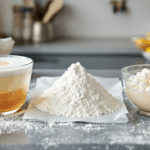The intoxicating scent of yeast working its magic, the visual delight of perfectly iced cupcakes, the communal warmth of a neighborhood bakery – the dream of owning such a place is deeply appealing. It speaks to creativity, craft, and connection. But transforming this heartfelt vision into a viable, thriving business demands more than just exceptional baking skills and passion. It requires a strategic foundation: a comprehensive bakery business plan.
Many passionate food entrepreneurs, particularly those starting small, initially dismiss the idea of a formal business plan. It might seem like bureaucratic overkill, something reserved for slick corporate offices or nerve-wracking bank loan applications. This perception, however, is a dangerous misconception. Failing to plan is, essentially, planning to fail, especially in the competitive food industry. Without a roadmap, you’re navigating blind, susceptible to cash flow crises, market misjudgments, operational chaos, and ultimately, the heartbreaking closure of your dream venture. Your business plan isn’t just a document; it’s your strategic compass, your reality check, and your blueprint for building a sustainable and profitable bakery.
Why Every Baker Needs a Business Plan (Even if You’re Starting Small)
Let’s knead this point further: why dedicate precious time to planning when you could be perfecting your sourdough starter?
- Transforms Passion into Strategy: It forces you to move beyond the “I love baking” stage and ask critical business questions. Who will buy your products? How will you reach them? How will you price your goods to make a profit? How will you differentiate yourself? Writing it down makes your ideas tangible and testable.
- Provides Clarity and Focus: The process demands defining your bakery’s identity. Are you a high-end patisserie, a rustic bread haven, a gluten-free specialist, or a cheerful cupcake shop? This clarity informs everything – from your branding and location choice to your menu and marketing messages.
- Uncovers Potential Pitfalls (Before They Cost You): Thorough planning involves research – into your market, your competition, and your costs. This foresight allows you to anticipate challenges. Perhaps the local market is saturated with cupcake shops, suggesting a different niche might be wiser. Maybe the cost of premium organic flour significantly impacts your projected profit margins, requiring a pricing strategy adjustment. Identifying these issues on paper is far less costly than discovering them after you’ve signed a lease and bought equipment.
- Essential for Attracting Investment and Loans: If external funding is part of your strategy (and for many startups, it is), a professional business plan is non-negotiable. Lenders and investors need to see that you’ve done your homework, understand the risks, and have a credible plan for generating returns. It showcases your professionalism and the viability of your dream.
- Acts as a Management Tool: Your business plan isn’t meant to gather dust in a drawer after opening day. It’s a living document. It sets goals and milestones against which you can measure your actual performance. Are sales meeting projections? Are costs staying within budget? Regularly reviewing and updating your plan helps you stay on track, adapt to changing market conditions, and make informed decisions for growth.
- Aligns Your Team (Even if it’s Just You Initially): As you potentially bring on partners or employees, the business plan serves as a shared understanding of the bakery’s goals, values, and strategies. It ensures everyone is pulling in the same direction.
Key Ingredients of Your Bakery Business Plan
A robust bakery business plan is built from several interconnected sections. Don’t feel pressured to perfect each one immediately. Start drafting, research as you go, and let the plan evolve.
1. Executive Summary: Your Bakery at a Glance
Think of this as the enticing aroma wafting from your bakery door – it needs to draw people in. Although positioned first, write this section last, after you’ve fleshed out all the other details. It’s a concise, compelling overview of your entire plan, typically one to two pages long. Its goal is to capture the reader’s interest and convince them your bakery concept is worth exploring further.
Must-Haves:
- Compelling Opening: Start with your mission or a powerful statement about the problem you solve or the niche you fill.
- Business Concept: Clearly state what type of bakery you are opening, your core offerings, and your unique selling proposition.
- Target Market: Briefly identify your primary customer base.
- Competitive Edge: Why will customers choose you over others?
- Management Team Highlights: Briefly mention key personnel and their relevant expertise.
- Financial Snapshot: Include projected startup costs, funding sought (if any), and key financial projections (e.g., projected revenue for year 1, anticipated profitability timeline). Make it realistic but confident.
- The Ask (If applicable): Clearly state what you are seeking (e.g., “$50,000 loan for equipment and working capital”).
2. Company Description: What Makes Your Bakery Special?
This section delves into the heart and soul of your business. It’s where you paint a vivid picture of your bakery’s identity.
- Detailed Bakery Concept: Go beyond a simple label. Describe the atmosphere, the customer experience, the specific focus. Examples:
- Artisan Sourdough Specialist: Focus on long fermentation, local grains, education about bread. Rustic, knowledgeable vibe.
- Modern Patisserie: Elegant pastries, macarons, custom cakes. Chic, sophisticated ambiance, potentially higher price point.
- Neighborhood Comfort Bakery: Classic cookies, pies, muffins, friendly service. Cozy, welcoming atmosphere, focus on community.
- Dietary-Focused Bakery: Exclusively gluten-free, vegan, or keto. Clear labeling, emphasis on safe handling, building trust with a specific community.
- Ethnic Specialty Bakery: Focusing on baked goods from a specific culture (e.g., French viennoiserie, Mexican pan dulce, Italian pasticceria). Authenticity is key.
- Legal Structure: Detail your chosen business entity.
- Sole Proprietorship: Easy to set up, but no legal distinction between you and the business (personal liability).
- Partnership: Similar to sole proprietorship but with multiple owners. Requires a strong partnership agreement.
- Limited Liability Company (LLC): Offers liability protection, separating personal assets from business debts. Often a good choice for small businesses.
- Corporation (S-Corp/C-Corp): More complex structure, offers liability protection, potentially more attractive to investors. Different tax implications.
- Actionable Tip: Consult with a small business attorney and an accountant to determine the best structure for your specific situation and location.
- Mission, Vision, and Values: These aren’t just corporate buzzwords.
- Mission: Your purpose. Why do you exist beyond making money? (e.g., “To enrich our community with handcrafted, high-quality baked goods made from locally sourced ingredients.”)
- Vision: Your long-term aspiration. Where do you want to be in 5-10 years? (e.g., “To be the most beloved artisan bakery in the downtown district, known for innovation and community engagement.”)
- Values: The guiding principles behind your actions. (e.g., Quality, Community, Sustainability, Creativity, Customer Joy). How will these values show up daily? (e.g., ‘Sustainability’ might mean compostable packaging and reducing food waste).
- Unique Selling Proposition (USP): What genuinely makes you different and desirable? It needs to be something customers value. Examples beyond the obvious:
- Hyper-local ingredient focus.
- Exceptional, personalized customer service model.
- A unique signature item nobody else offers.
- Specific baking technique (e.g., wood-fired oven).
- Strong community partnerships or social mission integration.
- Unbeatable speed/convenience for certain items (e.g., morning coffee & pastry rush).
- Validation: How do you know your USP matters? Talk to potential customers, run small surveys, test market samples.
3. Market Analysis: Understanding Your Customers and Competition
This section proves you’ve looked beyond your own kitchen and understand the commercial landscape. Assumptions here are dangerous; research is paramount.
- Detailed Target Market Analysis: Go beyond “everyone who likes cake.”
- Demographics: Age, income level, family status, occupation, location (e.g., residents within a 2-mile radius, office workers in nearby buildings).
- Psychographics: Lifestyle (health-conscious, convenience-driven, indulgent), values (supports local, seeks organic), interests (foodies, families looking for treats).
- Behavioral: Purchase habits (daily bread buyer, special occasion cake orderer, weekend treat seeker), brand loyalty.
- Geographic: Where do they live, work, and shop?
- Persona Development: Create 1-3 fictional representations of your ideal customer (e.g., “Meet ‘Artisan Annie,’ a 35-year-old graphic designer who values quality, aesthetics, seeks out unique food experiences, and regularly buys sourdough bread and specialty pastries.”). This helps visualize and target your marketing efforts.
- Market Size, Trends, and Opportunities:
- Research Methods: Use local census data, Bureau of Labor Statistics industry reports, Chamber of Commerce resources, local economic development agencies, competitor observation, customer surveys, online trend reports (e.g., search for “bakery industry trends 2025”).
- Key Trends: Identify relevant trends like the rise of online ordering/delivery apps, demand for plant-based/vegan options, increasing interest in artisanal/craft products, gluten-free Celiac needs, focus on sustainability and transparent sourcing, the “experience” economy (e.g., beautiful spaces, workshops).
- Market Opportunity: Based on trends and local gaps, where does your specific concept fit in? Is there unmet demand?
- In-Depth Competition Analysis: Identify and analyze:
- Direct Competitors: Other bakeries (specialty and general), cafes with strong pastry programs.
- Indirect Competitors: Supermarkets with in-store bakeries, high-end restaurants with dessert offerings, potentially even home bakers selling locally.
- Analysis Framework (SWOT): For each key competitor, analyze their Strengths (what they do well), Weaknesses (where they fall short), Opportunities (areas they could improve or expand, which might be threats to you), and Threats (their strengths that directly challenge you).
- Key Comparison Points: Product range, quality, pricing, location, atmosphere, customer service, online presence, marketing tactics, apparent target audience. Use a simple table for comparison.
- Goal: Determine how to effectively differentiate your bakery and carve out your market share.
4. Products and Services: What Will You Bake and Sell?
Connect your baking passion with business viability.
- Detailed Menu Strategy:
- Core Offerings: List your main categories and signature items.
- Variety vs. Specialization: Will you offer a wide range or focus intensely on perfecting a few things?
- Seasonality: Plan for seasonal specials using fresh, local ingredients (e.g., berry tarts in summer, pumpkin spice in fall).
- Menu Engineering Basics: Consider which items are high-profit vs. high-popularity. Aim for a balance. Analyze food cost percentage (cost of ingredients / selling price) for key items. (Detailed costing is for a later article, but acknowledge its importance here).
- Ingredient Sourcing and Supply Chain:
- Supplier Identification: Research potential vendors for flour, sugar, butter, eggs, specialty items, packaging. Get quotes and compare quality/reliability.
- Quality Standards: Define your non-negotiables (e.g., cage-free eggs, local dairy, specific chocolate brand).
- Building Relationships: Good supplier relationships are crucial for consistency and potentially better pricing.
- Backup Plans: What happens if your primary flour supplier has a shortage? Identify backup options.
- Scalability and Diversification: Think long-term.
- Catering: Office meetings, parties, events. Requires different packaging, logistics, potentially staffing.
- Custom Orders: Birthday cakes, wedding cakes. Requires specialized skills, consultation time, and clear ordering processes.
- Wholesale: Selling to local cafes, restaurants, or retailers. Requires consistent production, delivery capabilities, different pricing structure.
- Baking Classes/Workshops: Leverages your expertise, creates community engagement, additional revenue stream.
- Merchandise: Branded mugs, aprons, tote bags, potentially selling specialty ingredients you use.
- Online Sales Platform: For pre-orders, local delivery, or even shipping certain durable goods.
5. Marketing and Sales Strategy: How Will You Reach Customers?
Amazing baked goods don’t sell themselves. You need a plan to connect with your target market.
- Comprehensive Branding:
- Brand Identity: Beyond logo/name – what is the personality and voice of your bakery (e.g., warm and friendly, sophisticated and artistic, quirky and fun)?
- Visual Elements: Logo, color palette, typography, packaging design, shop decor, staff uniforms, website aesthetics – all should be consistent and reflect your brand.
- Pricing Strategy Considerations: Briefly touch upon the factors influencing your pricing (linking to the dedicated article):
- Cost-Plus Pricing: Calculating costs and adding a markup.
- Value-Based Pricing: Pricing based on perceived customer value (often higher for unique/artisanal items).
- Competitor-Based Pricing: Aligning prices with competitors.
- Positioning: Premium pricing signals high quality, while lower prices might attract budget-conscious customers. Ensure it aligns with your brand and target market.
- Multi-Channel Promotional Plan:
- Pre-Opening Buzz: Social media teasers, local press announcement, “coming soon” signage.
- Grand Opening Event: Make it memorable! Samples, special offers, local influencer invites.
- Digital Marketing: Professional website with menu/online ordering, active social media presence (Instagram/Facebook are key for visual appeal), local SEO (Google My Business), targeted online ads, email list building and newsletters.
- Local/Community Marketing: Flyers in community centers, partnerships with neighboring businesses, sponsoring local events, loyalty programs, punch cards.
- Public Relations (PR): Reach out to local food bloggers and journalists.
- Sales Channels and Customer Experience:
- In-Store: Focus on ambiance, efficient service flow, friendly staff interaction, tempting displays.
- Online Ordering: User-friendly platform, clear photos, accurate descriptions, reliable pickup/delivery process.
- Farmers’ Markets/Pop-ups: Great for testing products, building brand awareness, direct customer interaction. Requires logistics planning.
- Customer Service: Define your service standards. How will you handle complaints or special requests? Excellent service builds loyalty.
6. Operations Plan: The Day-to-Day Dough
This covers the practical mechanics of running your bakery efficiently and legally.
- Location Analysis (Deep Dive): Factors beyond “good spot”:
- Visibility & Accessibility: Easy to see and reach by foot/car?
- Foot Traffic: Does the right kind of customer pass by?
- Parking: Is it available and convenient?
- Zoning & Ordinances: Ensure the location is zoned for food service and understand local regulations.
- Proximity: Near complementary businesses? Near your target audience? Far enough from direct competitors?
- Lease Terms: Rent, duration, clauses, tenant improvement allowances. Review carefully with legal counsel.
- Efficient Layout Design:
- Workflow Mapping: Visualize the flow: Receiving -> Storage -> Prep -> Mixing -> Baking -> Cooling -> Finishing/Decorating -> Display/Packaging -> Sales. Minimize steps, avoid bottlenecks.
- Health Code Compliance: Design must meet local health department standards (handwashing sinks, grease traps, proper ventilation, distinct areas for raw/cooked food prep if applicable).
- Ergonomics: Design workstations to be comfortable and efficient for staff.
- Customer Area: Consider seating (if any), queueing space, display case visibility, payment station efficiency.
- Equipment: Needs vs. Wants:
- Essential: Commercial ovens (convection, deck), mixers (floor, countertop), work tables (stainless steel), refrigeration (reach-in, under-counter, walk-in?), sinks (3-compartment, handwashing, prep), proofing cabinets, dough sheeter (depending on products), display cases (ambient, refrigerated).
- Desirable/Specialty: Blast chiller, specific molds, decorating tools, espresso machine, POS system.
- Sourcing: Research new vs. reputable used equipment suppliers. Consider leasing options to conserve capital. Factor in installation and maintenance costs.
- Systems and Procedures:
- Standard Operating Procedures (SOPs): Document key processes (recipes with exact measurements/methods, opening/closing procedures, cleaning schedules, handling cash). This ensures consistency, simplifies training, and maintains quality.
- Inventory Management: Implement a system (even a detailed spreadsheet initially) to track ingredients and finished goods. Monitor stock levels, track usage, calculate food costs, minimize waste (First-In, First-Out rotation).
- Point of Sale (POS) System: Choose a system that handles sales, tracks inventory, manages customer data, and provides sales reports.
- Supplier Management:
- Develop Relationships: Consistent orders and timely payments foster good partnerships.
- Quality Control: Check deliveries for accuracy and quality.
- Negotiate Terms: Explore payment terms and potential bulk discounts (once established).
7. Management Team: Who’s Running the Show?
Investors (and even banks) invest in people as much as ideas. Showcase your strengths and acknowledge where you need support.
- Founder(s) Profile: Detail your baking experience, any business management or culinary qualifications, previous relevant work history. Be honest about your passion and drive.
- Skills Gap Analysis: Honestly assess your strengths and weaknesses. Are you a brilliant baker but inexperienced in finance? A marketing whiz with limited operational knowledge? Identify areas where you might need training, mentorship, or to hire expertise.
- Organizational Structure: Even if starting solo, map out future roles (e.g., Head Baker, Counter Staff, Decorator, Delivery Driver, Manager). Define responsibilities for each role.
- Advisory Board (Optional but Recommended): Consider assembling an informal board of advisors – mentors, industry contacts, an accountant, a lawyer, a marketing expert – who can offer guidance and support.
- Partners/Key Personnel: If applicable, provide detailed bios for partners or key hires, emphasizing their relevant skills and experience.
8. Financial Plan: The Numbers Behind the Dream
This is where the dream meets reality. Be thorough, realistic, and conservative in your projections. Seek help from an accountant if needed.
- Detailed Startup Costs: Itemize everything needed to open the doors:
- Leasehold Improvements/Renovations
- Rent Deposit & First Month’s Rent
- Commercial Kitchen Equipment (purchase or lease down-payment)
- Smallwares (pans, utensils, bowls)
- Licenses and Permits (health, business, food handler)
- Initial Inventory (ingredients, packaging)
- POS System (hardware & software)
- Signage & Branding Materials
- Marketing Launch Budget
- Legal & Accounting Fees
- Utility Deposits
- Working Capital Buffer (Crucial! Enough cash to cover 3-6 months of operating expenses before you turn a profit).
- Provide a Range: Research typical costs in your area to create a realistic estimate (e.g., “Estimated startup costs range from $X to $Y”).
- Funding Sources and Uses:
- Sources: Detail exactly where the money will come from: personal savings, family/friends loans (formalize these!), bank loans (SBA-backed, conventional), microloans, investors (angel, venture capital – less common for small bakeries initially), crowdfunding.
- Uses: Specify how the requested funds will be allocated across the startup cost categories.
- Comprehensive Financial Projections (First 3-5 Years):
- Sales Forecast: Project revenue based on estimated average customer spending, number of customers per day/week, seasonality. Base this on your market analysis and capacity. Be conservative initially.
- Personnel Plan: Forecast staffing costs as you grow.
- Profit and Loss (P&L) Statement: Projects revenue, cost of goods sold (COGS – ingredients, direct labor), gross profit, operating expenses (rent, utilities, salaries, marketing, insurance), and net profit/loss over time.
- Cash Flow Statement: Tracks the actual cash coming in and going out. Vital for managing liquidity and avoiding shortfalls. Shows if you can pay bills on time.
- Balance Sheet: Snapshot of assets (what you own), liabilities (what you owe), and equity (owner’s investment) at a specific point in time.
- Break-Even Analysis: Calculate the sales volume needed to cover all fixed and variable costs. Knowing this number is critical.
- Underlying Assumptions: Clearly state the assumptions behind your numbers (e.g., “Assumes an average transaction value of $Z,” “Projects customer traffic increasing by X% after 6 months”).
Tips for Writing an Effective Bakery Business Plan
- Allocate Sufficient Time: Don’t rush it. Good planning takes research and thoughtful consideration.
- Use Templates and Software (Wisely): Resources like the Small Business Administration (SBA) website, SCORE, and business plan software (e.g., LivePlan, Bizplan) can provide structure, but tailor the content heavily to your specific bakery. Don’t just fill in the blanks generically.
- Research, Research, Research: Validate your assumptions with real data whenever possible. Talk to potential customers, suppliers, and other non-competing business owners.
- Be Specific and Quantify: Instead of “increase sales,” use “increase sales by 15% in Year 2 by introducing a corporate catering menu.”
- Maintain a Professional Tone and Format: Ensure it’s well-organized, easy to read, and free of errors. Use headings, bullet points, and potentially charts/graphs for clarity.
- Get Constructive Feedback: Share drafts with trusted advisors, mentors, or potential lenders/investors and be open to their critiques.
- Remember It’s a Journey: Your first draft won’t be perfect. The value is in the process of thinking through each element.
Your Recipe for Success: Beyond the Document
Creating your bakery business plan is arguably the most critical non-baking task you’ll undertake. It’s an exercise in discipline, foresight, and strategic thinking. It transforms your delectable dream from a fleeting idea into a structured venture with a significantly higher chance of success. While passion fuels the oven, a solid plan steers the ship. Embrace the process, be thorough, be realistic, and lay the foundation for a bakery that not only delights taste buds but also thrives as a business.







